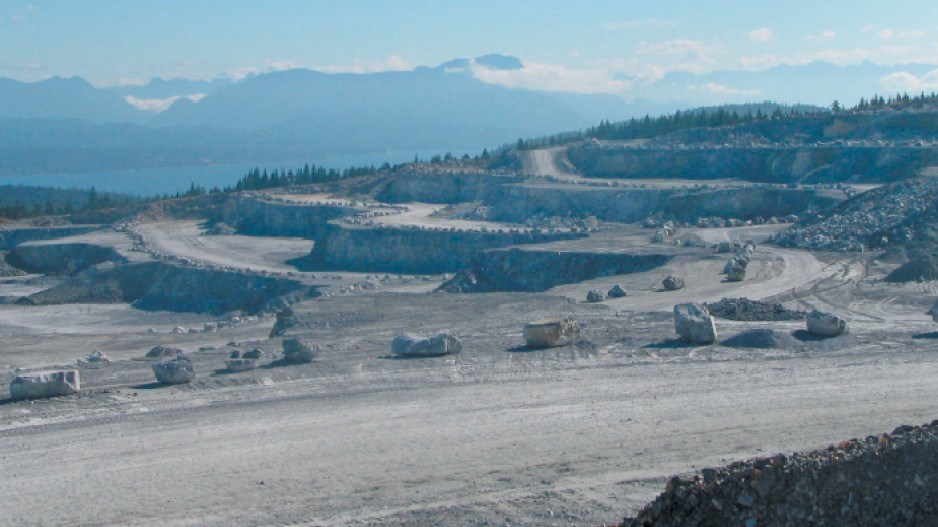As the proposed transfer point for thermal coal shipped from an expanded Fraser Surrey Docks destined for Asia, Lafarge’s (Euronext:LG) Texada Quarrying Ltd. has been wrapped up in a heated jobs- versus-environment battle for much of the past year.
But beyond the contentious coal debate, Texada Quarrying, a large-scale limestone quarry located on Texada Island, has another story to tell. At 61 years old, it’s the oldest mine in British Columbia. And it isn’t slowing down any time soon.
“Texada Quarrying is a very, very sustainable operation for us. We believe it’s a 200-plus year deposit,” said Jonathan Moser, director of environment and public affairs at Lafarge.
“We see it as a resource that will serve our business for a long time.”
On average, Texada Quarrying produces about four million tonnes of limestone per year. Its record year was in 2008, when 8,000,000 tonnes of limestone was produced. The quarry currently employs 90 people.
All of the limestone mined at Texada is barged – the quarry has a port facility, one of the reasons it is being considered as a transfer facility for the coal from the Fraser Surrey Docks expansion – to a cement plant in Richmond, also owned by Lafarge. Limestone is the main ingredient used to make cement.
That industrial use, said Moser, is a source of pride for Lafarge. Because cement is routinely used in sidewalks, curbs and bridges, to name but three examples, a constant supply of it is critical.
“This is a commodity that goes into many facets of people’s everyday lives,” said Moser.
“It is central to our infrastructure needs. It all begins with the mining of limestone.”
Texada Island has a rich history mining limestone. Prospectors first started mining limestone on the island, in small operations, in 1918. In the 1930s, however, the industry starts to grow.
“Texada was very, very active in mining in those days,” said Heather Harbord, a Powell River-based writer who wrote a book on the history of the island.
“It was just going gangbusters.”
The most influential player in Texada’s limestone history was businessman Fred Beale. In the early 1930s, Beale bought his first limestone quarry on Texada, on the east side of the island, from the Powell River Company. He ran the quarry for years before eventually passing it on to his son, Stan, to manage.
In 1952, Beale started Texada Quarrying. In 1956, Beale sold the quarry to a company called Ideal Cement. Ideal sold to Holderbank North America, a Swiss company now known as Holcim Group (LSE:HOLN), in 1989. Finally, the quarry was sold to Lafarge in 1998.
Pete Styles, a longtime resident of Texada Island, was hired by Stan Beale in 1966 to develop limestone projects on the west side of the island.
In his more than 30-year- career, the now 84-year-old Styles worked on numerous limestone jobs, managing everything from simple rock-crushing sites to helping build a barge-loading facility in Beale Cove named after Fred Beale.
It was good work and it paid the bills, Styles said. But it wasn’t just a gig that kept his family clothed and fed. Limestone mining has sustained the island.
“If it weren’t for limestone, Texada Island would be a retirement community,” said Styles.
“And if we were just a retirement community, there would be no school and real future. A retirement community can only last for so long.”
And like Lafarge’s predictions, Styles believes limestone mining will keep future generations at work on Texada.
After all, the world needs limestone, he said.
“I’m not surprised it’s the oldest operation in the province. People use limestone all over the place,” said Styles.
“We’re going to keep using it. As long as we’re building bridges, we’ll keep mining limestone. It’s small price to pay for the benefit of everybody.” •




